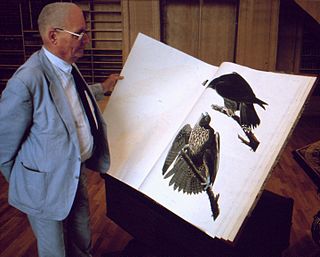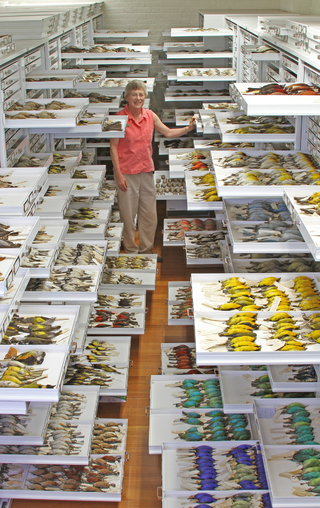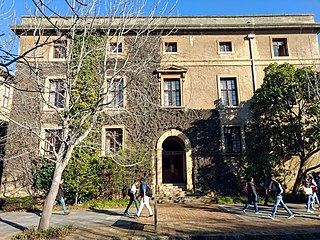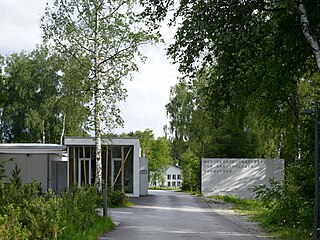
Ornithology is a branch of zoology that concerns the study of birds. Several aspects of ornithology differ from related disciplines, due partly to the high visibility and the aesthetic appeal of birds. It has also been an area with a large contribution made by amateurs in terms of time, resources, and financial support. Studies on birds have helped develop key concepts in biology including evolution, behaviour and ecology such as the definition of species, the process of speciation, instinct, learning, ecological niches, guilds, island biogeography, phylogeography, and conservation.

Bird migration is the regular seasonal movement, often north and south, along a flyway, between breeding and wintering grounds. Many species of bird migrate. Migration carries high costs in predation and mortality, including from hunting by humans, and is driven primarily by the availability of food. It occurs mainly in the northern hemisphere, where birds are funnelled onto specific routes by natural barriers such as the Mediterranean Sea or the Caribbean Sea.
Charles Gald Sibley was an American ornithologist and molecular biologist. He had an immense influence on the scientific classification of birds, and the work that Sibley initiated has substantially altered our understanding of the evolutionary history of modern birds.
The British Ornithologists' Union (BOU) aims to encourage the study of birds (ornithology) around the world in order to understand their biology and aid their conservation. The BOU was founded in 1858 by Professor Alfred Newton, Henry Baker Tristram and other scientists. Its quarterly journal, Ibis, has been published continuously since 1859.

The American Ornithological Society (AOS) is an ornithological organization based in the United States. The society was formed in October 2016 by the merger of the American Ornithologists' Union (AOU) and the Cooper Ornithological Society. Its members are primarily professional ornithologists, although membership is open to anyone with an interest in birds. The society publishes the two scholarly journals, Ornithology and Ornithological Applications as well as the AOS Checklist of North American Birds. The American Ornithological Society claims the authority to establish standardized English bird names throughout North and South Americas.

Erwin Friedrich Theodor Stresemann was a German naturalist and ornithologist. Stresemann was an ornithologist of extensive breadth who compiled one of the first and most comprehensive accounts of avian biology of its time as part of the Handbuch der Zoologie. In the process of his studies on birds, he also produced one of the most extensive historical accounts on the development of the science of ornithology. He influenced numerous ornithologists around him and oversaw the development of ornithology in Germany as editor of the Journal für Ornithologie. He also took an interest in poetry, philosophy and linguistics. He published a monograph on the Paulohi language based on studies made during his ornithological expedition to the Indonesian island.

Jean Dorst was a French ornithologist.
The Cornell Lab of Ornithology is a member-supported unit of Cornell University in Ithaca, New York, which studies birds and other wildlife. It is housed in the Imogene Powers Johnson Center for Birds and Biodiversity in Sapsucker Woods Sanctuary. Approximately 250 scientists, professors, staff, and students work in a variety of programs devoted to the Lab's mission: interpreting and conserving the Earth's biological diversity through research, education, and citizen science focused on birds. Work at the Lab is supported primarily by its 75,000 members.

Ibis, subtitled the International Journal of Avian Science, is the peer-reviewed scientific journal of the British Ornithologists' Union. It was established in 1859. Topics covered include ecology, conservation, behaviour, palaeontology, and taxonomy of birds. The editor-in-chief is Dominic J. McCafferty. The journal is published by Wiley-Blackwell in print and online. It is available free on the internet for institutions in the developing world through the OARE scheme.

Bird collections are curated repositories of scientific specimens consisting of birds and their parts. They are a research resource for ornithology, the science of birds, and for other scientific disciplines in which information about birds is useful. These collections are archives of avian diversity and serve the diverse needs of scientific researchers, artists, and educators. Collections may include a variety of preparation types emphasizing preservation of feathers, skeletons, soft tissues, or (increasingly) some combination thereof. Modern collections range in size from small teaching collections, such as one might find at a nature reserve visitor center or small college, to large research collections of the world's major natural history museums, the largest of which contain hundreds of thousands of specimens. Bird collections function much like libraries, with specimens arranged in drawers and cabinets in taxonomic order, curated by scientists who oversee the maintenance, use, and growth of collections and make them available for study through visits or loans.

The FitzPatrick Institute of African Ornithology is a South African biological research and conservation institute based at the University of Cape Town. The mission statement of the institute is “to promote and undertake scientific studies involving birds, and contribute to the practice affecting the maintenance of biological diversity and the sustained use of biological resources”.
The Cooper Ornithological Society (COS), formerly the Cooper Ornithological Club, was an American ornithological society. It was founded in 1893 in California and operated until 2016. Its name commemorated James Graham Cooper, an early California biologist. It published the ornithological journal The Condor and the monograph series Studies in Avian Biology. It presented the annual Loye and Alden Miller Research Award, which is given for lifetime achievement in ornithological research and was a member of the Ornithological Council.

The Rossitten Bird Observatory was the world's first ornithological observatory. It was sited at Rossitten, East Prussia, on the Curonian Spit on the south-eastern coast of the Baltic Sea. It was established by German ornithologist Johannes Thienemann and operated until 1944. In 1945 East Prussia was divided between Poland, Russia and Lithuania, and most ethnic Germans expelled.
Dominique G. Homberger is an Alumni Professor the Louisiana State University, where she taught for 31 years. She is noted for her work on the evolution of complex structures in birds, mammals, and fish, and is also the author of a textbook on vertebrate dissection. A fellow of the American Association for the Advancement of Science and the American Ornithological Union, she served as the President of the International Ornithological Congress 2022, and President of the International Ornithologists' Union from 2018-2022.
Dioscoro Siarot Rabor, also known as Joe Rabor, was a Filipino ornithologist, zoologist, and conservationist. Known as the "Father of Philippine Wildlife Conservation", he led more than 50 wildlife expeditions in the Philippines, authored 87 scientific papers and articles, and described 69 new bird taxa and numerous mammal species.

John Weaver Fitzpatrick is an American ornithologist primarily known for his research work on the South American avifauna and for the conservation of the Florida scrub jay. He is currently the Louis Agassiz Fuertes Director of the Cornell Lab of Ornithology in Ithaca, New York.

André Desrochers is a Quebec scientist with expertise in ornithology and ecology.

The Mongolian Ornithological Society), was founded in 1999 in the capital city, Ulaanbaatar. It is non-profit environmental organisation dedicated to the research and conservation of birds and their habitats, and also other wildlife in Mongolia. It publishes a peer-reviewed annual scientific journal, Ornis Mongolica, and other bird-related books, guidebooks and papers on bird research works and conservation activities in Mongolia and other countries. The Society raises funds for conservation and educational activities by arranging bird watching and wildlife tours to different parts of Mongolia. The society puts great emphasis on educating young researchers and raising public awareness on conservation. Its board members consist of well-known ornithologists, biologists and ecologists from Mongolia and other countries. In collaboration with the Ornithological Laboratory at the National University of Mongolia, a total of more than 30 scientific theses by bachelors, masters, and Ph.D. students have been supervised by members of the society.
Tatiana Borisovna Ardamatskaya was a Soviet-Ukrainian ornithologist and conservationist. She is known for her research on waterbirds and coastal birds of the Ukrainian Black Sea region and for her efforts to improve environmental protections for them. Her studies included Mediterranean gulls, swans, eiders, ducks, geese, and terns, among others.

The Max Planck Institute for Ornithology was a non-university research institution under the sponsorship of the Max Planck Society (MPG). As of 1 January 2023, it merged with the Max Planck Institute for Neurobiology (MPIN) to form the new Max Planck Institute for Biological Intelligence (MPI-BI). The MPIO was located in Seewiesen, which belongs to the municipality of Pöcking in Upper Bavaria.













